« Getting ready for first ever open water dives | Main | We are PADI CERTIFIED! »
August 5, 2006
TWO DOWN! (and two to go)
Listen up, bandicoots.... diving in open water ain't the same as in the pool!
If you've never done it, it'll be a big surprise. It's all different. For me it was my first two open water dives after weeks of classroom work and "confined water" pool diving and exercising. I have to admit, I was nervous. And I HATE to get up early. But we had to be there at 7AM sharp, and so I was. Browns Ravine, Folsom Lake, California. Amanda and Stacy were already there, and after a bit of searching we found the right spot.
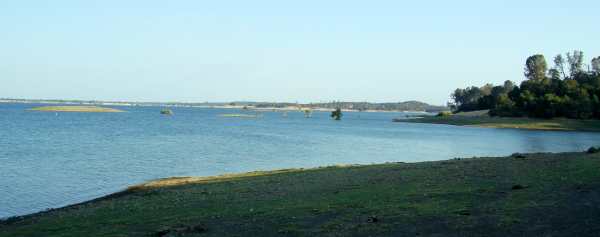
So then it was unloading all the gear, and that's where a whole bunch of little logistical thingies came into play that aren't ever discussed in class, nor are they in any video or textbook. Where do you park your gear? Like right next to the water? Or do you set up some sort of base camp? At Folsom Lake it's a fairly steep descent down to picnic tables and then down to the beach. So we shlepped our gear to the tables, then left some there and took the rest down by the lake. Umm... what do you do with your valuables? Will there always be someone tending the farm? Like a "security buddy" or "designated gear watcher"? Even if you leave all your stuff in the car, what about the car key? Put that in a pocket of your BC or clip in somewhere? Not with today's electronic keys you don't.
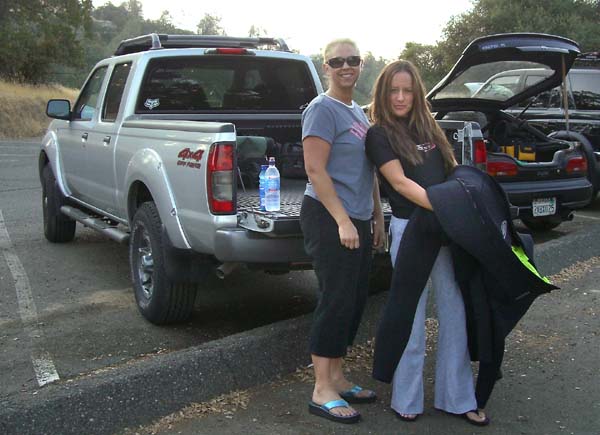
Fortunately, a few family members accompanied us eight aspiring divers and so security was taken care of. Julie and Spencer got lost and so we had some extra time to get all set up. The picture above shows Amanda and Stacy.
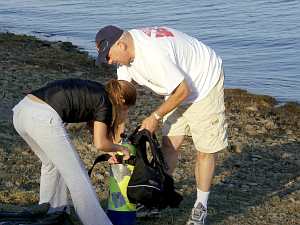 Okay... where to start? It was actually much colder than I thought at 8am on an August 5th in California. Water temperature almost 80 degrees, air much cooler. So I struggled into the bottom part of my "Farmer Johns"... just to find that I had them on the wrong way. Off they came. And back on. No fun, even though they were not very tight. Instructor Chuck is in a splendid mood, but excuses himself to go to the bathroom before he gets geared up (I'd soon find out why).
Okay... where to start? It was actually much colder than I thought at 8am on an August 5th in California. Water temperature almost 80 degrees, air much cooler. So I struggled into the bottom part of my "Farmer Johns"... just to find that I had them on the wrong way. Off they came. And back on. No fun, even though they were not very tight. Instructor Chuck is in a splendid mood, but excuses himself to go to the bathroom before he gets geared up (I'd soon find out why).
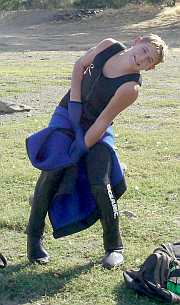 So down by the beach we go, including one big 80 cu-ft tank and the rest of the gear, dunk the BC in the water, and assemble the tank/BC/regulator. This time Holly is my buddy; she'd already taken the course and been in the lake several times, but had not done all her certification dives due to some problems up in Lake Tahoe. We're rather loose about how and where to put on fins and BC and all, and I struggle a bit as I can't see my feet/fins at all in the muddy water. And the BC weighs a ton with the much bigger 80 cu-ft tank, so I make it float and put it on in the water. It seems to leak a bit, but Chuck says it's just overinflated.
So down by the beach we go, including one big 80 cu-ft tank and the rest of the gear, dunk the BC in the water, and assemble the tank/BC/regulator. This time Holly is my buddy; she'd already taken the course and been in the lake several times, but had not done all her certification dives due to some problems up in Lake Tahoe. We're rather loose about how and where to put on fins and BC and all, and I struggle a bit as I can't see my feet/fins at all in the muddy water. And the BC weighs a ton with the much bigger 80 cu-ft tank, so I make it float and put it on in the water. It seems to leak a bit, but Chuck says it's just overinflated.
Continuing in the tradition of whatever I fear not happening and whatever I don't expect happening, I have no problem at all with the wetsuit. Water isn't sloshing around, it feels nice and tight without being restrictive. It may look like crap, but it sure works. The mouthpiece, on the other had, chaves against my gums. Oh, and shlepping all the heavy gear brought on some disconcerting pain signals from my lower back.
So then it's time to go down into the lake, a real lake, real open water... my very first real dive. What will it be like? What will I see? Will I be able to compensate? Will I freak?
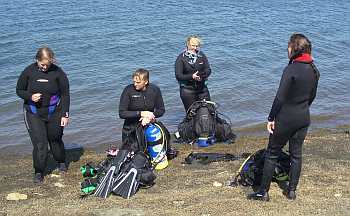 Instructor Chuck explains the scenery and the plan. He refers to the "parking lot" and then the rocks beyond it. Parking lot? Well, it IS a parking lot. During the fall and winter time the water level in the lake (created by the huge Folsom Dam) is much lower and it is indeed a parking lot. So down we go and I find myself floating over a parking lot. Really weird. Visibility is quite limited, perhaps ten feet, so we all stay close together.
Instructor Chuck explains the scenery and the plan. He refers to the "parking lot" and then the rocks beyond it. Parking lot? Well, it IS a parking lot. During the fall and winter time the water level in the lake (created by the huge Folsom Dam) is much lower and it is indeed a parking lot. So down we go and I find myself floating over a parking lot. Really weird. Visibility is quite limited, perhaps ten feet, so we all stay close together.
We pass the edge of the parking lot and now it goes down. At perhaps 20 feet we hit a thermocline. Now we all had read about thermoclines, but you have to experience one to really know what it means. It goes from warm to really cold just like that. It's spooky initially, as if you'd hit "the deep," some sort of cold and clammy dead zone.
Now we're at the bottom, perhaps 25 feet or so. Equalizing turns out not being much of a problem. It's really just doing more of what we had to do in the pool. I sort of had expected both ears to equalize the same time, or at least make the same sounds. They don't. And you never quite know when you have to equalize, or what technique might work.
 Chuck had warned us not to touch the silty bottom with our fins, but that is easier said than done. So before long visibility drops to perhaps five feet. We gather around Chuck and do some exercises. Partial mask flooding and clearing. Not too much. Just getting used to being down there in a real lake, in real open water. Then we dive around a bit, not seeing very much at all. I quickly lose my buddy Holly (I know, I know...). And I realize that, perhaps as part of the thermocline, I have to pee real bad. But up we go, slowly, passing back into warmer water, then breaking the surface. It'd felt like we had been down there for an hour. But it'd only been 15 minutes.
Chuck had warned us not to touch the silty bottom with our fins, but that is easier said than done. So before long visibility drops to perhaps five feet. We gather around Chuck and do some exercises. Partial mask flooding and clearing. Not too much. Just getting used to being down there in a real lake, in real open water. Then we dive around a bit, not seeing very much at all. I quickly lose my buddy Holly (I know, I know...). And I realize that, perhaps as part of the thermocline, I have to pee real bad. But up we go, slowly, passing back into warmer water, then breaking the surface. It'd felt like we had been down there for an hour. But it'd only been 15 minutes.
Oh, and another big surprise! One of my major worries had been that I would not be able to see the instruments because I need 2.0 reading glasses. Amazingly, underwater everything was crystal clear. That was much more of a difference than I expected. I knew underwater opitcs make everything seem 1/3 larger and closer, but the effect is greater than expected.
Now I have to go really bad and know why Chuck emptied his bladder before donning his suit. I trek over to the restrooms and struggle out of my suit enough too pee. Life is good. After 50 minutes or so we're ready for the second dive.
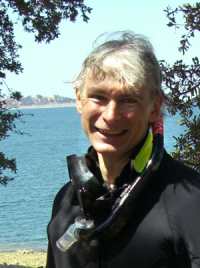 This time getting all geared is a little easier, though I am certain Carol would chide me for the, shall we say, 'inconsistent' habits I have acquired. Once we're all set up and ready to roll, Chuck explains the second dive. We're doing surface navigation out to the anchored buoy, snorkeling. Once there, we'll descend to the bottom, just short of 30 feet, and will do full mask flooding and clearing, and then a simulated emergency out-of-air. Chuck will point at one of us who will acknowledge, sigal the buddy, do the out-of-air sign, wait for the buddy to make the alternate air supply available, and then descend to the surface.
This time getting all geared is a little easier, though I am certain Carol would chide me for the, shall we say, 'inconsistent' habits I have acquired. Once we're all set up and ready to roll, Chuck explains the second dive. We're doing surface navigation out to the anchored buoy, snorkeling. Once there, we'll descend to the bottom, just short of 30 feet, and will do full mask flooding and clearing, and then a simulated emergency out-of-air. Chuck will point at one of us who will acknowledge, sigal the buddy, do the out-of-air sign, wait for the buddy to make the alternate air supply available, and then descend to the surface.
So we set our compass bearings and off we go. I strictly follow the course, sure that I'll hit the buoy any minute, but then I hear Chuck calling me. I look at and the buoy is way off to the side. How did this happen? Well, even if you follow the course exactly, a current can carry you off, which is what happened to me. Once there we give each other signs, then descend...
Into what can best be described as pea-soup. Once again I almost immediately lose my buddy, Holly. I see Julie and Spencer who also seem lost, so they make the ascend sign and I follow, slowly. By the time I am up, I see no one. So I swim over to the buoy and descend down the line, joining Chuck and the other three.
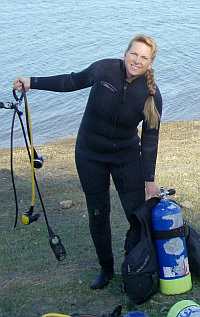 Actually, all I can see is a faint outline of Holly, who's all of two feet away, and Chuck's mask inches away from me. Viz is that bad. So I do the full mask flooding, no problem. Holly does the same. Then do (or approximate) fin pivots and then some neutral buoyancy floating. All in pea-soup. Chuck pulls Holly and I close and signals that I am out of air. I signal Holly who releases her BC-mounted alternate for herself and gives me her primary. I signal okay, and we slowly ascend to the surface.
Actually, all I can see is a faint outline of Holly, who's all of two feet away, and Chuck's mask inches away from me. Viz is that bad. So I do the full mask flooding, no problem. Holly does the same. Then do (or approximate) fin pivots and then some neutral buoyancy floating. All in pea-soup. Chuck pulls Holly and I close and signals that I am out of air. I signal Holly who releases her BC-mounted alternate for herself and gives me her primary. I signal okay, and we slowly ascend to the surface.
Chuck finishes with the others, then asks us to do some "tired diver" tows. Fun, that, and so Holly and I ferry around until all are done with the pea-soup exercises.
Now Chuck wants us to reset the compass for another landmark, swim in that direction for four minutes, then do a 90 degree left, all at depth. Down Holly and I go, trying to follow the compass. I think I am doing it just right, but then the needle veers way off and Holly, whom I had seen just seconds ago, has disappeared again. So I ascend, to find her bobbing on the surface a ways away. I decided to go down again, diving over to her. With marginal success. Holly and I seem unable to hang on to each other. So next time I'll make her lead and I follow!
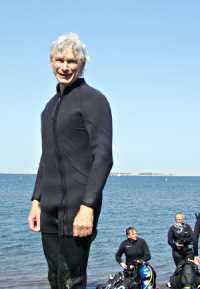 I use the rest of my time diving towards the shore, closely watching my instruments, noticing how I ascend and descend, and how my ears react to the pressure difference. I try to establish totally neutral buoyancy, be horizontal in the water, fin just right, and all that is fun. Then I approach the shore, and the rest of the crew as well.
I use the rest of my time diving towards the shore, closely watching my instruments, noticing how I ascend and descend, and how my ears react to the pressure difference. I try to establish totally neutral buoyancy, be horizontal in the water, fin just right, and all that is fun. Then I approach the shore, and the rest of the crew as well.
We struggle out of the water, employing various methods taking off our gear and hefting it up the slope. We compare notes; everybody did reasonably well, though a few things misfired. Julie had vicious heartburn the whole time. Spencer's snorkel came off and got lost. One of the others could not pressure compensate her ears and had to ascend. Stacey, who had seemed quite intimidated and afraid, beams as she did well. Amanda is getting used to her gear, after some initial problems with getting properly weighted.
Chuck now wants our log books and so we sit down and make our first two entries. Dive 1 and Dive 2. Yeah! Lots of data. I help out some of the others. Then we hand them in, try to get dry, try not to get our gear too dirty, try to get it all back up to the cars without collapsing. :-)
Then it's driving home. I am both elated and exhausted. As I write this it is hours later. I went to the Hudson Dive Center to get my tank refilled. I am still elated and more exhausted yet. Still, I managed to hose off my gear, write all this, and relate my experiences.
Now I am going to lay down. I have a slight headache. I am told, hey, it's the nitrogen. From such shallow and short dives, I ask? Yep. Go have a nap. Will do. -- Conrad
Posted by conradb212 at August 5, 2006 10:57 PM








